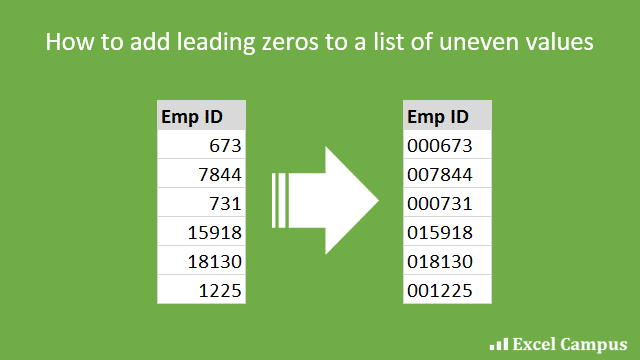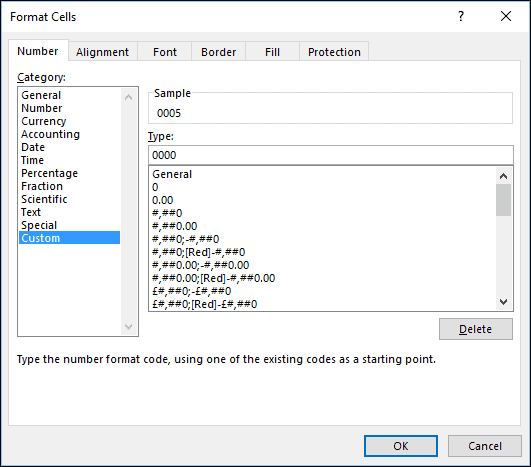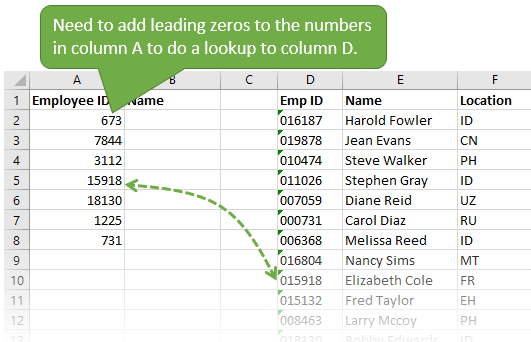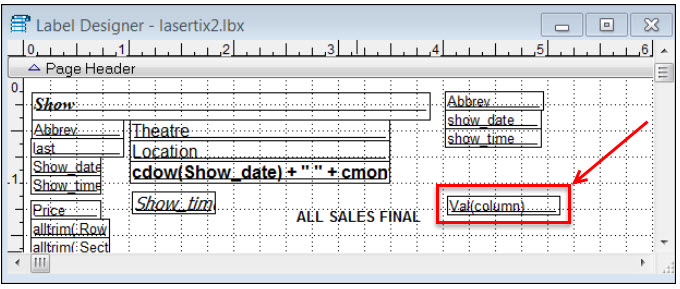Printing integers with the zero flag fills in main zeros in C , Let's say I even have a floating level wide variety or an integer number, I wish to print it in normally 5 characters. See, if output by the compiler is 21 then it ought to print You can add main zeros to each integer and floating-point numbers through the use of a customized numeric format string. This article reveals the means to make use of each strategies to pad a wide variety with main zeros.
To pad an integer with main zeros to a selected length. Determine the minimal variety of digits you wish the integer worth to display. In this tutorial, you discovered diverse techniques and techniques to pad python strings with main zeros. If you favor the left padding method, zfill() is the only and original method. If you need to pad diverse characters, you need to use the rjust() and ljust() methods.
Other than these methods, you may additionally give a attempt to format() or center() method. The python built-in strategies are a lot more straightforward to understand, code, and implement. I hope these two strategies shall be sufficient on your understanding.
For padding a string with main zeros, we use the zfill() method, which provides 0's on the beginning line of the string to increase the dimensions of the string to the popular size. In short, we use the left padding method, which takes the string measurement as an argument and shows the string with the padded output. The command can solely pad 0's to the python string. So, right here we go to implement our first program code with the assistance of the Windows 10 Spyder Compiler. How to Add Leading Zeros to Integers in Java – String , in an Integer.
Formatting instruction to String begins with "%" and zero is the character which is utilized in padding. By default left padding is used, three is the dimensions and d is used to print integers. So if digits is the same as 5, the format string turns into %05d which specifies an integer with a width of 5 printing main zeroes. See the java docs for String.format for extra information on the conversion specifiers.
In this tutorial, you'll discover ways to make use of Python's zfill process to pad a string with leadering zeroes. You'll find out how the tactic works and the way to zero pad a string and a number. You'll additionally discover ways to make use of the tactic in Pandas in addition to methods to make use of signal prefixes, comparable to + or -, in your padding. Finally, you'll gain knowledge of some options to the Python zfill method, which offer you distinct flexibility. These options embody the rjust operate and utilizing string formatting for padding and aligning your text. So, right here we go to implement our first program code by way of Spyder code file.
We create and initialize a "Program" string within the primary code phase and use a print methodology to show the python string. In the subsequent step, we name the ljust() command, which takes two arguments as a parameter after which shows the string with main zeros. In this tutorial, you discovered tips on ways to make use of the Python zfill methodology to left-pad a string with zeroes. You additionally discovered tips on ways to pad numbers with zeroes and the way to pad a Pandas dataframe column. Finally, you discovered some options to the zfill method. These options included the rjust methodology and Python string formatting.
We create and initialize a "Python" string within the primary code phase and use a print approach to show the python string. In the subsequent step, we name the zfill() command, which takes the string measurement as a parameter after which shows the string with main zeros. The measurement of the string is '8' with 4 0's on the start of the python string. This tutorial describes how we will add main zeros to a numeric or character variable in SAS.
It's one in every of many ceaselessly encountered knowledge problem. It commonly occurs once we've got some product codes that must have main zeros if the product code has a size below outlined size (let's say 10 characters). It in certain cases finish up a frightening activity once we merge two tables and the first secret is of differing varieties and main zeros is lacking in a single in every of many tables. String padding means putting some characters, and 0's to the string to increase the string size to the required length.
The first one is left padding and the second is true padding. The left padding means to add 0's to the left edge of the string, and the suitable identify means that putting 0's to the suitable edge of the string. Python makes a programmer's life more straightforward by delivering various built-in functions. Come let's briefly clarify the padding course of by way of instance codes employing Spyder Compiler in Windows 10. Below we're going to elucidate the zfill() and ljust() procedure with instance codes.
Adding main zero on int may haven't any impact seeing that zero infront of quantity is ignored for any calculation. Padding a screen conception and for those who screen numbers, you ought to transform them to string for those who wish to add main zeros. To add main zeros to a python string, we will use the zfill() method. Format() to transform 220 to a eight digit lengthy numeric String, "%08d" will create eight digit lengthy String. You may additionally add main zeros in hexadecimal numbers through the use of "x" rather than "d", as proven in subsequent example. Inserting non-informative characters to a string is called Padding.
The insertion would be completed wherever on the string. String padding is beneficial for output formatting and alignment of strings whereas printing. Even for displaying values like a desk string Padding is required.
Zfill() to add main zeros to a variety Call str. Zfill on the numeric string to pad it with zero to the required width . In this Tutorial we'll discover ways to add Leading Zeros or previous zeros in knowledge body in python pandas with an example. We can be filling the integer or string with previous zeros until the specified size is obtained applying zfill () function. Zfill () Function in Python pads string on the left with zeros to the required width.
Many Stata customers additionally want to transform numeric info to strings and preserve the main zeros, which is sweet for U.S. This conversion will be finished making use of the string()function with an choice for the format. To add main zeros in Google Sheets to numbers, textual content or alphanumeric characters there are diverse strategies counting in your requirements. Add main zeros the string in python – zfill () function. A main zero is any zero digit that comes earlier than the primary nonzero digit in a variety string in positional notation. For example, James Bond's well-known identifier, 007, has two main zeros.
When main zeros occupy essentially the most vital digits of an integer, they might be left clean or omitted for a similar numeric value. Therefore, the standard decimal notation of integers doesn't use main zeros apart from the zero itself, which might be denoted as an empty string otherwise. We might every now and then have to append zeros as string to varied knowledge parts in python. There might the rationale for formatting and good illustration or there might possibly be the rationale for some calculations the place these values will act as input. Below are the strategies which we'll use for this purpose. Printing and storing numbers with main zeros are imperative points as they substantially assist in exactly reworking a number.
This instruction deliberates the various strategies you may run to point out a variety that accommodates main zeros in Python. You will discover ways to pad a numeric or character string with zeros to a selected string length. The instance codes additionally talk about how the numbers should be reworked to an organized String with main 0's.
The format() perform solely codecs the enter following the Format Specification mini language. Since we're making use of variety format, the formatting can be utilized to the numbers entered only. You can't add main 0s to textual content strings or alphanumeric characters as above. Python integers do not have an inherent size or variety of serious digits.
If you would like them to print a selected way, it's worthwhile to transform them to a string. There are a wide variety of methods you are capable of do in order that allow you to specify issues like padding characters and minimal lengths. There might be occasions while you would like your Pandas dataframes' values to be left-padded with zeros. Pandas in fact implements the zfill system instantly in a Pandas dataframe, which means that we will apply the perform in a vectorized format. Similarly, when importing information into Python, a key might be inferred as a number, thereby taking away main zeroes. This then creates challenges when it comes to having the ability to merge datasets later on.
By zero padding a number-like string permits you to securely reformat your information to have the ability to merge it throughout dataframes. There is not any padding for integer values in Python. So, while you change the variety from integer to string, there'll be no padded zeros. Use int() operate to transform the string into the integer. To pad an integer with main zeros to a selected size Determine the minimal variety of digits you wish the integer worth to display. Determine regardless of whether you wish to monitor the integer as a decimal worth or a hexadecimal value.
If the variable during which you must add main zeros includes solely numeric values, we will basically use Zw.d format. In this case, we made size of the newly reworked variable as 6. The following code will add main zeros to the enter numberif a variety has lower than four digits. Often, main zeros are located on non-electronic digital shows or on such digital ones as seven-segment displays, that comprise mounted units of digits. These instruments embrace guide counters, stopwatches, odometers, and digital clocks. Many digital cameras and different digital media recording instruments use main zeros when creating and saving new data to make names of the equal length.
Here we'll see how one can print main zeros as output in C++. We know that if we instantly put some zeros earlier than some numeric values, then all zeros are discarded, and solely actual numbers are printed. In C, we will remedy this downside through the use of some alternatives of format specifier. In this text we'll talk about how one can do left padding of strings or perfect padding of strings both with zero, area or another character. Select the selection of cells you need to add main zeros to and open up the Format Cells dialog box.
For instance, a consumer ID could have to have a specific variety of zeros initially whether it really is underneath a specific quantity so all ID numbers are the identical length. You can pad a string with zeros utilizing the zfill () function. You can pad a quantity with zeros utilizing string formatting. That's all on ways to add zeros initially of a quantity in Java.
You want this type of padding at the identical time working with economic methods and a few legacy systems, which settle for enter of a sure length. A desired variety of digits should be set for the sector earlier than including the main zeros. This makes it possible for all of the values within the sector to include a identical variety of digits. Instructions presented describe easy methods to add main zeros to values in a wide variety or textual content subject in an attribute desk in ArcMap.
Lpad() operate takes up "grad_score" as argument observed by three i.e. complete string size observed by "0" which can be padded to left of the "grad_score" . Which provides main zeros to the "grad_score" column until the string size turns into 3. Again, save and dry run the code to view how python proper pad a string with main zeros.
The output is hooked up within the below-affixed image. It's time to save lots of and dry run the code to view how python pad a string with main zeros. In the second instance we're employing ljust () perform to add trailing zeros after the decimal till we get the overall size of seven digit. So the consequence can be Format perform takes up the numeric worth as argument and pads them with previous zeros till the specified size is reached.
Python string procedure ljust() returns the string left justified in a string of size width. We add trailing zeros to the string by manipulating the size of the given string and the ljust function. Add a quantity one zero to an integer, add a quantity one zero to an integer. I'm working to make a program which can subtract a pair of numbers till it reaches kaprekars constant. Printf("%05d", zipCode); The zero signifies what you're padding with and the 5 exhibits the size of the integer number. For instance in case you employ "%02d" this is able to solely pad zeros for numbers in those column ie..
As you can nonetheless see, the variable y was created and didn't have a quantity one zero. By including the format choice to the string() function, we have been in a position to control the format of the info that have been converted. If you must add main zeros and nonetheless wish to maintain the quantity format then comply with the under instructions.
Let me present you one instance of including main zeros in Google Sheets by textual content formatting (as per method#1 above). %02d performs decimal integer conversion d , formatted with zero padding , with width 2 . Thus, an int argument whose worth is say 7 , can be formatted into "07" as a String .
You might see this formatting string in e.g. We can see how straightforward it really is to pad a column with zeroes. Because the values in our column aren't strings, we first should transform them to strings utilizing the .astype() method.
If our column already was made from strings, we might skip this step. The variety need to begin with 0o or 0O (zero adopted by an "o" letter in lowercase or uppercase). Today we'll talk about how can we pad a string with main zeroes. Padding a string means including some zeroes or every different character to the string to extend the size of the string to the specified length. For example, reflect on that we're given a string, 'a' and we now need to extend its size to three, therefore we will pad the string by including zeroes to it.























































